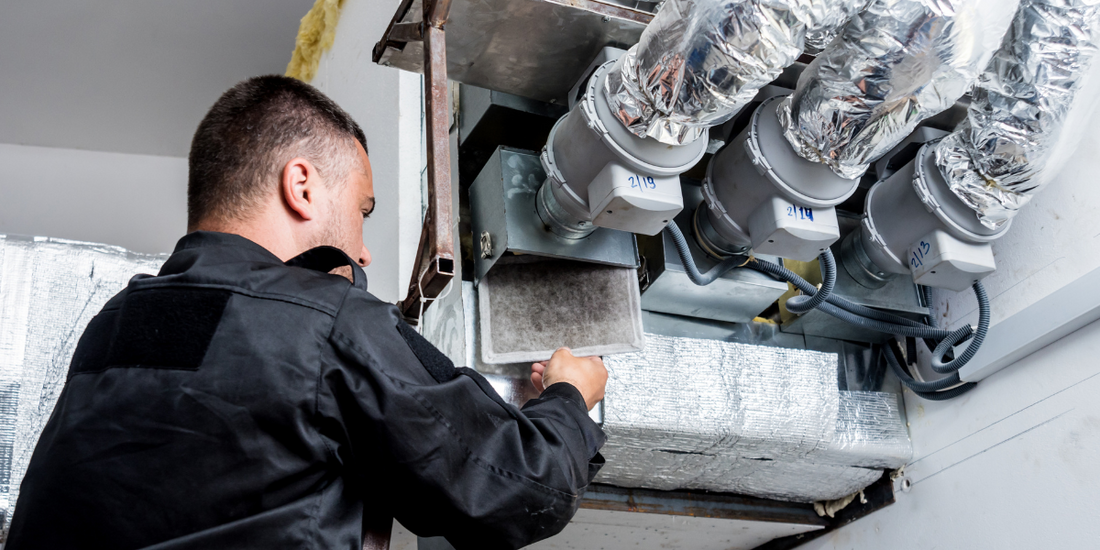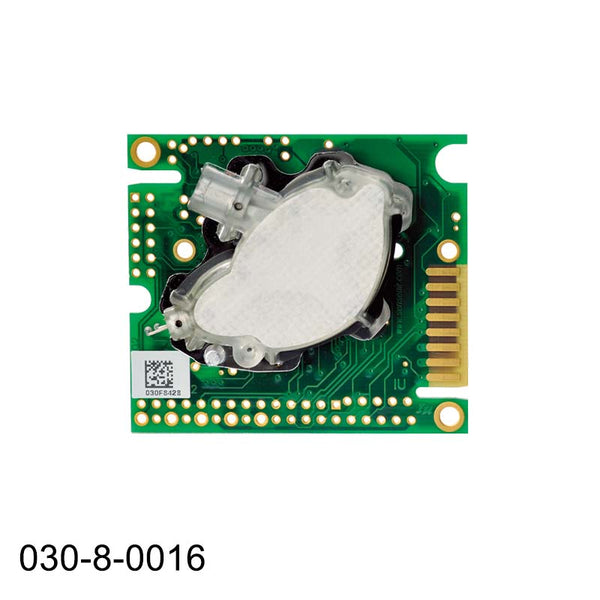
What is a CO2 sensor in HVAC?
Heating, ventilation, and air conditioning (HVAC) systems in homes, schools and office buildings commonly use carbon dioxide sensors to monitor and control indoor air quality.
CO2 gas sensors measure the amount of carbon dioxide in the air to monitor the performance of the HVAC system and insure the proper amount of fresh air is available for safety and comfort.
In addition to CO2 sensors, other HVAC sensors used monitor indoor air include:
- Temperature sensors for monitoring temperature
- Humidity sensors for monitoring humidity levels
- Pressure sensors to monitor air flow between zones
- Position sensors to open or close ducts
- Flow switches to provide feedback on air flow in ductwork
- Vibration sensors used in commercial cooling towers
- Gas sensors to monitor levels of specific gases like oxygen, carbon monoxide or combustible gases in the air
In addition, CO2 sensors are also used because guidelines continue to be issued for businesses to enhance ventilation and use carbon dioxide sensors to mitigate the transmission of air-borne illnesses.
Why do we need CO2 sensors?
Controlling and monitoring indoor levels of carbon dioxide is essential for human health, safety, and even energy efficiency in buildings. Ambient outdoor air is composed of approximately, 78% nitrogen, 21% oxygen and 0.04% carbon dioxide. Indoors, a lack of proper air circulation can dramatically alter the gas concentrations from being balanced and healthy, resulting in air full of pathogens.
Every home, classroom, or office building requires a constant flow of fresh, conditioned air to make it fit and comfortable for the people who work, learn, and live inside these environments. In the past, fresh air was not a problem because most buildings were porous, i.e. outdoor air “leaked” into the building around windows and under doors. Everyone has experienced a cold draft in an old house or building.
While “leaky” buildings ensure fresh air, they are also expensive to heat and cool. As energy prices have risen dramatically over the last few decades architects started designing new buildings that minimized energy loss - they call it "closing the envelope."
For example, throughout the 1970's many schools and office buildings were designed with permanently sealed windows. While this saved energy, it had the unexpected consequence of sealing in mold, bacteria, and potentially harmful gases like radon, VOCs (volatile organic compounds), and CO2. It had the additional unintended impact of creating fewer exits during dangerous school events.
What CO2 sensors are used in HVAC systems?
CO2 sensors measure CO2 levels from 400ppm (fresh air) to over 3,000 ppm (stuffy office) are used for indoor air quality. Therefore, CO2 sensors that measure in the range of 400 ppm to 10,000 ppm are typically used in HVAC applications.
For example, the K30 10,000 ppm CO2 Sensor is commonly used to measure the air composition in ventilation units to monitor the performance of HVAC systems in offices and commercial buildings.
To combat sick building syndrome, HVAC designers and installers developed systems to provide a constant flow of fresh, outdoor air into buildings.
The idea was that wasting energy to condition outdoor air was the price you had to pay to provide fresh air indoors. In some cases, these HVAC systems either provided non-stop fresh air, or they were set on timers that would open fresh air dampers when the building was occupied.
In many cases, the only solution to providing fresh air was to open a window.
In countries where energy is more expensive, an alternative method of providing fresh air was used. Instead of constantly providing fresh air, buildings used carbon dioxide sensors to “sense” when the buildings were occupied. When enough people enter a room, the CO2 level rises because of the CO2 from their exhaled breath, and the HVAC system begins to bring in the fresh air. When the people leave, the CO2 level drops because they are no longer breathing in the room, and the fresh air dampers close.
Because most common uses for carbon dioxide in HVAC applications were due to saving energy, this also often correlated to leading to higher productivity rates and healthier overall environments for individuals. In addition, compliance also served as a second benefactor as many architects and building owners needed to rely on CO2 measurements in pursuing certifications that required the use of demand control ventilation.
Research now tells us that sustainably designed buildings and DCV systems cost less to operate. According to a report by the US Department of Energy's Pacific Northwest National Laboratory government facilities with sustainable HVAC practices cost 19 percent less to maintain.
CO2 Sensors in HVAC applications
An example of CO2 monitoring and energy efficiency in HVAC is the Empire State Building. This skyscraper built in the 1930's had an energy-savings retrofit in 2011 including VAV systems controlled by CO2 transmitters. Building management reports that they had surpassed the energy savings originally guaranteed by the HVAC contractor for years. The third year the property lowered its energy costs by 15.9 percent, saving $2.8 million. Over the past few years, the program has generated approximately $7.5 million in savings.
This system of using CO2 monitoring devices to trigger/control HVAC systems is continuing across much of the U.S. Many commercial buildings are now designed to meet LEED (Leadership in Energy and Environmental Design) specifications. LEED was designed and is administered by the USGBC (United States Green Building Council) and the testing and certification of the program is conducted by the Green Business Certification Inc. (GBCI).
The LEED program provides a rating system for energy-efficient building design that correlates to cost savings for the buildings owners. Included in LEED are specifications for utilizing CO2 monitors and sensors to control fresh air circulation.

A CO2 monitor designed specifically for HVAC applications is the CO2, Temp, and RH Indoor Air Quality Monitor and Space Pro: Smart CO2, VOC, Temperature, and Humidity Monitor that both allow occupants to easily monitor and control levels specific for smart homes, classrooms, offices and commercial buildings.
In addition, these devices are designed specifically to meet the latest ASHRAE and LEED certifications.
Also note that the American Society of Heating and Refrigeration Engineers (ASHRAE) recommendation for not exceeding 1,000 ppm of CO2 in office buildings still applies, as well as current ASHRAE workplace safety limits.
In addition, for those users that wish to design their own installation many customers stand by the next generation of low power CO2 sensors like the LP8. These low-power sensors are already being designed into OEM Devices with long-life batteries and Wi-Fi so they can easily be installed in every room. They can report back to the HVAC system to modify the environment or confined space in real-time.
The impact of CO2 sensors on energy efficiency
CO2 sensors play a crucial role in improving energy efficiency in HVAC systems by optimizing ventilation based on real-time occupancy and air quality. Traditional HVAC systems often operate at a constant rate, leading to unnecessary energy consumption when spaces are unoccupied or require less ventilation.
However, with CO2 sensors, HVAC systems can adjust airflow dynamically by monitoring CO2 levels in the environment. This demand-controlled ventilation (DCV) approach ensures that fresh air is supplied only when needed, significantly reducing energy usage and operational costs.
By continuously monitoring indoor CO2 levels, HVAC systems equipped with CO2 sensors can balance indoor air quality with energy efficiency, ensuring a healthier environment without wasting energy.
This not only lowers utility bills for building owners but also helps businesses meet sustainability goals, making CO2 sensors an essential component in modern, energy-efficient buildings. Additionally, by improving ventilation efficiency, these sensors contribute to reduced HVAC system wear and tear, extending the equipment's lifespan and reducing maintenance costs over time.
What is the difference between a CO2 and VOC Sensor?
One of the main questions we receive regarding CO2 sensors in HVAC, is the question, "What's the difference between a CO2 and VOC sensor?".
While CO2 sensors are vital in HVAC applications, VOC sensors are also used in order to monitor air quality but detect different types of pollutants and serve a different purpose.
When it comes to VOC sensors they typically are used to detect volatile organic compounds. This helps identify potential sources of indoor air pollution and are also essential in maintaining a good indoor air environment.
For more information on VOC sensors, read this article "CO2 Sensors vs. VOC Sensors" by CO2Meter.
For more information on selecting the proper indoor air quality solution or technology contact us.
Benefits of using CO2 sensors in commercial HVAC systems
Integrating CO2 sensors into commercial HVAC systems offers a range of benefits, from improving energy efficiency to enhancing indoor air quality. One of the primary advantages is demand-controlled ventilation (DCV), which adjusts airflow based on real-time CO2 levels, ensuring that fresh air is provided only when needed.
This leads to significant reductions in energy consumption, as the HVAC system doesn't over-ventilate spaces that are unoccupied or have low occupancy. As a result, businesses can lower their energy costs while maintaining optimal indoor conditions, making CO2 sensors an essential tool for energy-efficient building management.
Additional benefits of using CO2 sensors in HVAC include:
- Lower Energy Costs: By preventing over-ventilation in unoccupied or low-occupancy areas, businesses can significantly lower utility bills.
- Increased Comfort and Productivity: Proper ventilation leads to a healthier, more comfortable environment, boosting employee productivity and well-being.
- Compliance with Air Quality Regulations: CO2 sensors help maintain air quality levels that meet regulatory standards.
- Support for Green Building Certifications: Using CO2 sensors can help businesses achieve sustainability certifications like LEED by optimizing energy efficiency and indoor air quality.
- Extended HVAC System Lifespan: Reduced strain on HVAC systems from optimized ventilation leads to lower maintenance costs and longer equipment life.
Choosing the right CO2 sensor for your HVAC system
Selecting the right CO2 sensor for your HVAC system is essential for maximizing energy efficiency and maintaining optimal indoor air quality.
When choosing a CO2 sensor, it’s important to consider factors like sensor accuracy, response time, and integration capabilities with your existing HVAC system.
High-precision sensors, like the K30 10,000ppm CO2 sensor, can accurately detect CO2 levels in parts per million (ppm) and are crucial for ensuring effective demand-controlled ventilation (DCV). Additionally, with a fast response time these sensors can quickly adjust ventilation rates to match occupancy changes, improving both energy efficiency and indoor air comfort.
It's integral to also look for CO2 sensors that offer easy integration with smart HVAC controls, allowing seamless communication for real-time monitoring and adjustments. By choosing the right carbon dioxide sensor tailored to your building’s needs, you can significantly reduce energy consumption, improve air quality, and extend the lifespan of your HVAC equipment.
References:
- https://www.co2meter.com/blogs/news/14769149-co2-monitoring-for-leed-credit
- https://www.co2meter.com/blogs/news/4951322-results-are-in-green-buildings-save-green
- https://www.co2meter.com/blogs/news/7425418-occupancy-sensor-control-of-variable-air-volume-saves-energy-money
- https://www.bloomberg.com/news/articles/2021-01-11/how-to-know-if-a-building-has-good-ventilation
- https://www.cdc.gov/niosh/ventilation/faq/?CDC_AAref_Val=https://www.cdc.gov/coronavirus/2019-ncov/community/ventilation.html
- https://www.energy.gov/
- https://www.ashrae.org/technical-resources/bookstore/standards-62-1-62-2







